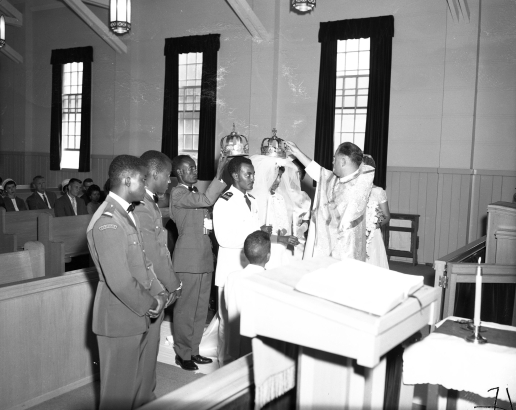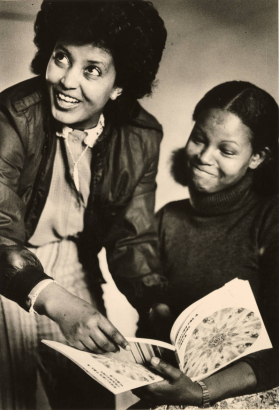The Ethiopian diaspora is recognized as a more recent migration into Colorado, but Ethiopians have a longer history in the state than people may realize. Many leaving Ethiopia today are fleeing the horrific atrocities being committed in the Tigray region of Northern Ethiopia, but the first major influx of immigrants and refugees from Ethiopia began after the Derg military junta took place in 1974, and lasted for over a decade.
Prior to a 1974 coup, Haile Selassie had ruled the country since 1930 and engineered a fascinating relationship with various Western powers who could be, at times, both colonizers and allies. In 1935, Mussolini’s forces invaded Ethiopia from the Italian colony of Eritrea. In time, and with help from the British, the Ethiopians successfully expelled Italian forces. This marked the beginning of a long history of Ethiopia’s relationship with the Allied forces, including the United States. It wasn't long after World War II that this relationship led to the arrival of the first Ethiopians in Colorado.
One of the confusing things involved in researching this issue is the fact that “Ethiopian” was a term used in the early 20th century by both African Americans and white society to refer to African Americans. In 1903, for example, a mutual aid society was started in Pueblo called the Ethiopian Protective and Beneficial Aid Society. This early use of the term may stem from the movement of “Ethiopianism” in Africa that began establishing distinct African churches on a continent full of churches established by colonial missionaries. Overlapping use of the term aside, we were able to locate a verifiable Ethiopian presence in Colorado that preceded the 1970s diaspora by decades.
Amongst our vast collection of photos from famed Denver photographer Burnis McCloud, are a set of negatives labeled, “Ethiopian Wedding.” The images show a traditional Ethiopian wedding attended by a number of Ethiopian airmen at what appears to be Lowry Airfield in the early 1950s. The presence of these airmen was likely indicative of a cooperative training program since, during this same period, members of the Ethiopian military were also serving with the American 7th Infantry Division in Korea.
On June 24, 1962, the Denver Post reported on Lt. Abebe Abate of the Ethiopian Air Force who had attended the Armament School at Lowry, and was about to start attending University of Colorado. In 1977, a group of seven Ethiopian airmen were ordered home by the leaders of the Ethiopian junta. While six returned home, Sgt. Million Assefa refused to return, as he was already enrolled at University of Colorado, Boulder. He had support in this decision from American colleagues and various agencies working on his asylum claim.
In 1980, the United States Congress passed the Refugee Act. Among other things, this act increased the annual admission of refugees into the country from 17,400 to 50,000. The ensuing growth in immigration brought people from many nations, including Ethiopia. In 1981, Denverite Tsegaye Hailu, a hydro-geologist from Tigray, Ethiopia, organized a group of other Ethiopians to help newly arrived refugees find work and adjust to their new country. Over the next decade, Ethiopians continued to come to the US to escape political strife and famine. By 1991, the US had further increased the number of refugees allowed to enter, but all refugees were not considered equal. On June 1, 1991 the Denver Post reported that, while 50,000 would be allowed in from the Soviet Union and 52,000 from East Asia, only 4,900 would be allowed in from the entire African continent.
Ethiopia has some of the oldest Christian, Jewish, and Muslim sects in the world. As immigrant families began to settle into their new communities in Colorado, they founded new Ethiopian churches like St. Mary’s Ethiopian Orthodox Church, and mosques like Bilal Masjid. In Denver, churches like St. Mary’s served not only the need of community and religious practice for local Ethiopians, but they also organized events to aid those back in Ethiopia facing a 21st century drought. Like for so many groups that make their way to the US, the suffering of those back home is not soon forgotten. In 2000, Yoseph Tafari, deacon at St. Mary’s told the Denver Post,
“This is a humanitarian issue that transcends other issues. Children are the victims.” Denver Post August 25, 2000
The city of Denver has also nurtured its relationship with Ethiopia in an official way. In 1997, as part of the Sister Cities program, Clayton Park, at Martin Luther King, Jr. Blvd. and Cherry Street, was renamed City of Axum Park. Axum is an ancient city in Ethiopia that also established its own Denver Park as part of the program. In 2009, Denver invested in the local park, installing irrigation, restrooms, landscaping, and African-themed artwork. In 2009, Metropolitan State College of Denver also established a partnership with Axum University. Both institutions agreed to exchange students and teachers to increase cultural understanding between people and promote learning.
By the early 2000s, the Ethiopian population of Colorado reached 30,000, with most residing in Aurora and the Denver-metro area. As the Ethiopian community became established as a part of greater Colorado, individual success stories began to percolate to the surface. Among them were kids like Musso Walio, who spent time in a Kenyan refugee camp, started South High School speaking no English, and went on to earn the Colorado Refugee Youth Scholarship and attend Colorado State University-Pueblo in 2010. Also notable was single mother Haime Asfaw, who fled the civil war with her son in 1982 and started the popular Arada Restaurant in Denver in 1998.
Notable Ethiopian refugees included social worker Shitta Damte Kassa, who served as a Unicef official in Ethiopia and worked to reunite Ethiopian and Sudanese child refugees with their families. Kassa was able to get his own family to Colorado in 2000, only to be diagnosed with terminal cancer soon after arriving here. Yohannes Gebregeorgis, a pharmacist in Ethiopia, earned his master’s in library science and worked at the San Francisco Public Library before founding a non-profit in Denver called Ethiopia Reads. The organization is no longer based in Denver, but continues to provide access to libraries and books for children across Ethiopia. As with all immigrant communities, what often begins as the struggle of individuals becomes one of triumph for the broader community across our state and nation.
For further reading:
Britannica, T. Editors of Encyclopedia. "Ethiopianism." Encyclopedia Britannica, November 21, 2017.
Exhibit - An Ethiopian Odyssey
BBC News. “How Did US and Ethiopia Become so Close?,” April 7, 2019, sec. US & Canada.
Migration Policy Institute. “The Ethiopian Diaspora in the United States.” July, 2014.
Goodstein, Phil. Park Hill Promise. Denver: New Social Publications, 2012.
Getahun, Solomon Addis. The history of Ethiopian immigrants and refugees in America, 1900-2000: patterns of migration, survival, and adjustment. New York: LFB Scholarly Pub., 2007.
"Ethnic Groups.Ethiopians", Clipping Files, Denver Public Library Special Collections, Denver, CO
"Axum (Ethiopia)-Denver Committee", n.d., WH1162, box 6, Denver Sister Cities International, Inc. Records, Denver Public Library Special Collections, Denver, CO





Comments
This is wonderful! The
This is wonderful! The photographs are beautiful. Thank you for the great history of the Ethiopian diaspora and their contributions to our community.
I am so glad you enjoyed it,
I am so glad you enjoyed it, Jim. Our Rocky Mountain News photo collection is a treasure trove and is also available to the public.
Thanks for sharing, Alex!
Thanks for sharing, Alex! Never knew any of this. Another reason to visit in person.
Thanks for reading, Dani. You
Thanks for reading, Dani. You are welcome to come look at our materials anytime!
"Ethiopian" was used as a
"Ethiopian" was used as a term in the mid-19th century for minstrel show performers. Before that, in Europe, it was a term for anyone from the Sub-Saharan region in Africa. It seems it's taken quite a while for the term to be properly used.
Another prominent Ethiopian in Denver was Daniel Yohannes, who became president of Colorado National Bank, then CEO of USBank's Colorado operation after it acquired Colorado National. He later was appointed by President Obama as CEO of the Millenium Challenge Corporation, a US foreign assistance organization.
Thanks so much for the
Thanks so much for the information about the strange misusage of "Ethiopian". I should also tell you that we do have a few photos of Daniel Johannes in the Rocky Mountain News Collection from his time in Colorado. Hopefully, we can digitize them at some point, but we also welcome anyone interested in coming in to look at them.
Add new comment